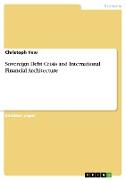- Start
- Sovereign Debt Crisis and International Financial Architecture
Sovereign Debt Crisis and International Financial Architecture
Angebote / Angebote:
Seminar paper from the year 2006 in the subject Business economics - Economic Policy, grade: 2.0, University of Osnabrück (Fachbereich Internationale Wirtschaftspolitik), course: Schuldenkrisen, 18 entries in the bibliography, language: English, abstract: If we have a look at the composition of total debt of different countries it is easy tosee (Figure 1.2) that from 1992 to 2002 the advanced countries' total debts mainlyconsisted of domestic currency, whereas those of emerging market countries wheremainly borrowed in foreign currency. If we focus our view on sovereign debt only, this difference vanishes. From 1980 to 2003 about 99.7 percent (Table 1) of sovereigndebt in emerging market countries was borrowed in foreign currency. In advancedeconomies it was slightly less (92.5%). Nevertheless, in both cases the U.S. dollar wasthe dominating foreign currency. A reason for this might be that this currency isconsidered as very important in international trade.A comparison between these facts leads me to the conclusion that private persons inadvanced countries trust their own currency, whereas private persons in emergingmarket economies seem to trust foreign currencies. Otherwise the currencycomposition between total debt and sovereign debt would not differ so much fromeach other. Another interesting fact concerns which other currencies states prefer toborrow in. They like advanced economies' currencies instead those of emergingmarket countries.Another important point concerning public debt structure is their compositionstructure concerning maturity. It can be seen (Figure 4.2) that during 1988 the averagematurity of sovereign debt issued in both kinds of countries was little below 8 years.But during the following 14 years the average maturity rate in emerging marketcountries decreased to about 5 years while the maturity rate of advanced countriessovereign debt increased to almost 10 years. This tendency towards short-term debtcan also be seen on Figure 4.1. It is interesting to note the fall in 1999 in both markets(Figure 4.2) which was nevertheless stronger in emerging countries.[...]
Folgt in ca. 10 Arbeitstagen
